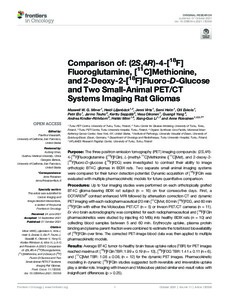Comparison of: (2S,4R)-4-[F-18]Fluoroglutamine, [C-11]Methionine, and 2-Deoxy-2-[F-18]Fluoro-D-Glucose and Two Small-Animal PET/CT Systems Imaging Rat Gliomas
Helin Semi; Oikonen Vesa; Li Xiang-Guo; Seppälä Kerttu; Liljenbäck Heidi; Yang Guangli; Elo Petri; Eskola Olli; Miner Maxwell WG; Minn Heikki; Virta Jenni; Roivainen Anne; Kindler-Röhrborn Andrea; Teuho Jarmo
https://urn.fi/URN:NBN:fi-fe2021120158498
Tiivistelmä
Purpose: The three positron emission tomography (PET) imaging compounds: (2S,4R)-4-[F-18]Fluoroglutamine ([F-18]FGln), L-[methyl-C-11]Methionine ([C-11]Met), and 2-deoxy-2-[F-18]fluoro-D-glucose ([F-18]FDG) were investigated to contrast their ability to image orthotopic BT4C gliomas in BDIX rats. Two separate small animal imaging systems were compared for their tumor detection potential. Dynamic acquisition of [F-18]FGln was evaluated with multiple pharmacokinetic models for future quantitative comparison.
Procedures: Up to four imaging studies were performed on each orthotopically grafted BT4C glioma-bearing BDIX rat subject (n = 16) on four consecutive days. First, a DOTAREM(R) contrast enhanced MRI followed by attenuation correction CT and dynamic PET imaging with each radiopharmaceutical (20 min [C-11]Met, 60 min [F-18]FDG, and 60 min [F-18]FGln with either the Molecubes PET/CT (n = 5) or Inveon PET/CT cameras (n = 11). Ex vivo brain autoradiography was completed for each radiopharmaceutical and [F-18]FGln pharmacokinetics were studied by injecting 40 MBq into healthy BDIX rats (n = 10) and collecting blood samples between 5 and 60 min. Erythrocyte uptake, plasma protein binding and plasma parent-fraction were combined to estimate the total blood bioavailability of [F-18]FGln over time. The corrected PET-image blood data was then applied to multiple pharmacokinetic models.
Results: Average BT4C tumor-to-healthy brain tissue uptake ratios (TBR) for PET images reached maxima of: [F-18]FGln TBR: 1.99 +/- 0.19 (n = 13), [F-18]FDG TBR: 1.41 +/- 0.11 (n = 6), and [C-11]Met TBR: 1.08 +/- 0.08, (n = 12) for the dynamic PET images. Pharmacokinetic modeling in dynamic [F-18]FGln studies suggested both reversible and irreversible uptake play a similar role. Imaging with Inveon and Molecubes yielded similar end-result ratios with insignificant differences (p > 0.25).
Conclusions: In orthotopic BT4C gliomas, [F-18]FGln may offer improved imaging versus [C-11]Met and [F-18]FDG. No significant difference in normalized end-result data was found between the Inveon and Molecubes camera systems. Kinetic modelling of [F-18]FGln uptake suggests that both reversible and irreversible uptake play an important role in BDIX rat pharmacokinetics.
Kokoelmat
- Rinnakkaistallenteet [19218]
